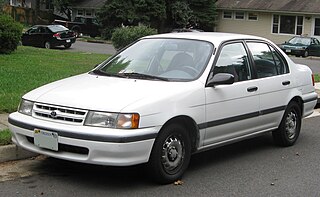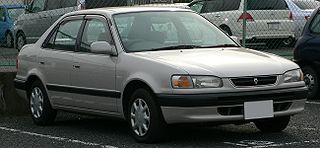
A manual transmission (MT), also known as manual gearbox, standard transmission, or stick shift, is a multi-speed motor vehicle transmission system, where gear changes require the driver to manually select the gears by operating a gear stick and clutch.

The Toyota Starlet is a subcompact car manufactured by Toyota from 1973 until 1999, replacing the Publica, but retaining the Publica's "P" code and generation numbering. The first generation Starlet was sold as the Publica Starlet in some markets. In Japan, it was exclusive to Toyota Corolla Store dealers.

The Toyota Vitz is a subcompact car produced by the Japanese automobile manufacturer Toyota from 1999 to 2019 in a three- or five-door hatchback body styles. The "Vitz" nameplate was used consistently in Japan, while most international markets received the same vehicle as the Toyota Yaris, or as the Toyota Echo in some markets for the first generation. The Vitz was available in Japan from Toyota's Netz Store dealerships. Toyota began production in Japan and later assembled the vehicle in other Asian countries and in France.

The Toyota K series is an inline-four engine that was produced from 1966 through 2007. It is a two-valve pushrod engine design. It was originally built from the Toyota Kamigo plant in Toyota City factory in Japan.
Toyota Motor Corporation's W family is a family of RWD/4WD transmissions built by Aisin. Physically, these transmissions have much in common with other Aisin-built transmissions, like the Jeep AX-5 and the Toyota G-series. The W55, W56, W57, W58, and W59 are externally and internally very similar aside from the gear ratios.
Toyota Motor Corporation's A family is a family of automatic FWD/RWD/4WD/AWD transmissions built by Aisin-Warner. They share much in common with Volvo's AW7* and Aisin-Warner's 03-71* transmissions, which are found in Suzukis, Mitsubishis, and other Asian vehicles.
Toyota Motor Corporation's R family is a family of 5-speed RWD/4WD transmissions built by Aisin. They share much in common with the Aisin AR transmission
Toyota Motor Corporation's T family is a family of 4/5/6-speed light/medium-duty transmissions found in Toyota cars.

The Toyota Tercel is a subcompact car manufactured by Toyota from 1978 until 1999 across five generations, in five body configurations sized between the Corolla and the Starlet. Manufactured at the Takaoka plant in Toyota City, Japan, and sharing its platform with the Cynos and the Starlet, the Tercel was marketed variously as the Toyota Corolla II — sold at Toyota Japanese dealerships called Toyota Corolla Stores — and was replaced by the Platz in 1999. It was also known as the Toyota Corsa and sold at Toyopet Store locations. Starting with the second generation, the Tercel dealership network was changed to Vista Store, as its badge engineered sibling, the Corolla II, was exclusive to Corolla Store locations.

The Toyota E engine family is a straight-four piston engine series, and uses timing belts rather than chains. The E engines were the first multi-valve engines from Toyota designed with economy, practicality and everyday use in mind. Like many other Toyota engines from the era, the E engine series features a cast iron block, along with an aluminium cylinder head. E engines are lighter than earlier Toyota engines, due to the hollow crankshaft, thinned casting of the cylinder block, and several other reductions in auxiliaries as well as in the engine itself. Carbureted versions include a newly designed, variable-venturi carburetor. All of these changes improved economy and emissions. The members of the E engine family, range from 1.0 L to 1.5 L. The E family supplanted the K engines in most applications. A large number of parts in the E engine series are interchangeable between each other.
The TREMEC TR-3650 is a 5-speed manual transmission for longitudinal engine automobiles. It includes a 5th gear that functions as an overdrive gear, light-weight aluminum housings, a synchromesh reverse gear, and synchromeshed helical cut forward gears. It is manufactured by Transmission Technologies Corporation and is rated for 360 lbf⋅ft (490 N⋅m) of torque. The loss in power transmission efficiency is rated at approximately 16% in 4th gear for a 2005–2010 Ford Mustang GT.

The Toyota Auris is a compact car derived from the Corolla, manufactured and sold by Toyota. Introduced in 2006, the first generation three/five-door hatchback shared the platform with the E150 series Corolla, while the second generation five-door hatchback and station wagon called "Touring Sports" uses the E180 platform. The "Auris" name is based on the Latin word for "gold", "aurum".
Toyota Motor Corporation's S family is a family of cable operated manual transmissions built for small to mid sized front wheel drive vehicles, but also used in mid-engine applications. The S family has received various upgrades and enhancements over its design life.

The Corolla E110 was the eighth generation of cars sold by Toyota under the Corolla nameplate.

The Toyota Corolla (E140/E150) is the tenth generation of cars sold by Toyota under the Corolla nameplate. The Toyota Auris replaced the Corolla hatchback in Japan and Europe, but was still badged "Corolla" in Australia and New Zealand.
Toyota Motor Corporation's E family is a family of 5/6-speed manual transmissions for FWD/RWD/4WD vehicles.

The Toyota K CVT transmission is a series of continuously variable transmissions (CVT) found in many Toyota and Lexus automobiles. The transmissions are manufactured for the company by Aisin, an automotive parts manufacturer that is part of the Toyota Group of companies. A CVT is a type of automatic transmission that can change seamlessly through a continuous range of gear ratios. This contrasts with other transmissions that provide a limited number of gear ratios in fixed steps. The K series uses two pulleys connected by a belt.
Toyota Motor Corporation's RC family is a family of 6-speed RWD/4WD transmissions. The RC transmission uses an output reduction method to achieve a compact construction. A double overdrive is used. A multi-cone synchromesh mechanism is used for 1st, 2nd, and 3rd gears to improve shift feel. Similar in some aspects to the older RA transmission, the RC features a separate clutch housing and uses a steel release bearing sleeve to improve serviceability and service life.
Toyota Motor Corporation's L-series of HybridSynergyDrive (HSD) transmissions are hybrid gearboxes containing 2 electric motors, one for driving the wheels and one for controlling the ratio between the engine and the electric drive motor, as well as an optional 2 or 4 speed planetary transmission attached to the end of the HSD device OR a conventional automatic transmission that uses an electric drive motor instead of a torque converter for additional vehicle propulsion.









